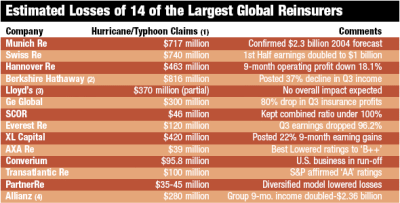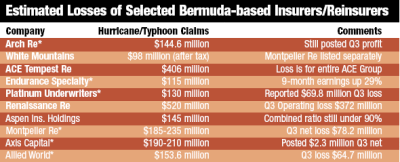This year’s annual report on the reinsurance industry is a bit later than usual. It seems that beginning in August the voyage was interrupted by some serious storms, and it was hard to catch up to the boat as it bounced around the raging seas.
Up until then the voyage had been going quite smoothly. Prices in most sectors seemed stable with some increasing and others decreasing. Most reinsurers were making the same encouraging noises about not chasing market share and underwriting for profitability. Loss experience remained relatively low.
Converium’s announcement that it would have to take more than $300 million in reserve charges on claims related to its U.S. business, the ratings downgrades and its subsequent withdrawal from that market was about the only storm on an otherwise untroubled horizon.

(2) Individual figures include GEICO and other Berkshire companies as well as Gen Re and National Indemnity.
(3) Lloyd’s has issued no overall estimate of syndicate losses; the figure is therefore partial. It includes estimates
from, Catlin, Wellington, Brit, Beazley and Kiln.
(4) Figure includes losses from Allianz Re and primary insurance.
Then the winds began to blow, as powerful hurricanes descended on Florida like the Four Horsemen of the Apocalypse. They may not have been named War, Famine, Pestilence and Death, but they were killers nonetheless. Charlie, Frances, Ivan and Jeanne killed over 70 people in the state and thousands more on Caribbean Islands, notably Haiti. They caused an estimated $50 billion in damages and, according to Insurance Services Office, $22 billion to $23 billion in insured losses. For good measure Chaba, Songda and Tokage, the most powerful typhoon in 10 years, ravaged large parts of Japan.
Just as the industry was beginning to deal with this series of disasters, it was hit by Hurricane Spitzer, as New York’s crusading attorney general launched a widespread probe of insurance industry practices, including inquiries into contingent commissions, bid rigging and the reinsurance industry’s “tying” primary policies to reinsurance contracts. It’s unclear exactly where that portion of Spitzer’s investigation will lead, but it has sent companies and brokers into a dither.

Natural catastrophes
The impact on the insurance industry in general and on reinsurers in particular from the hurricanes and typhoons was substantial. A survey of the 14 largest companies and groups–roughly in their 2003 order of ranking by A.M. Best–totals more than $4.5 billion, almost 5 percent of total insured losses (see chart on page N11). Bermuda-based reinsurers, including many formed after the Sept. 11 attacks, also suffered heavily (see chart on page N11). The totals include some primary claims as well as reinsurance losses and add up to over $2 billion, roughly a quarter from one company–Renaissance Re. Apparently not even CEO James Stanard’s famed mathematical models were able to predict the fourfold catastrophe.
The four hurricanes caused more losses than Andrew–roughly $20 billion in today’s dollars. Yet the serious shakeup in the reinsurance industry that occurred after Andrew is nowhere in evidence today. No new start-up companies have been announced, as was the case after the Sept. 11 attacks. Except for some smaller regional carriers, no companies have shown any evidence of slipping into insolvency–certainly no reinsurers. Third quarter profits were hit, but most companies are still well in the black for the first nine months of 2004.
Converium was the only major reinsurer to have serious financial trouble (from which it seems to have recovered), and that had nothing to do with hurricane related losses.
Beware the early gloat, but it seems that the reinsurance industry–after the battering it took in 2001–has finally heeded its own advice. Underwriting discipline and sound management limited the losses through a combination of refusing marginal business, further diversifying risks by sector and geography, advances in modeling techniques and their widespread adoption, and better capital management.
In a way, the hurricanes posed a test for the industry, which it seems to have passed with good grades.
Cycle management
If there had been no exceptional hurricanes or investigations, most of this report would have concentrated on the fluctuations in the insurance pricing cycle, which particularly affect the reinsurance industry. The debate centers on efforts to avoid the highs and lows that have affected premium rates seemingly forever. This in turn involves commitments to maintain underwriting standards, i.e., to make a profit on writing policies not on investments, and to forego lowering rates in order to gain a greater market share.
“Any softening of the [reinsurance] market doesn’t appear to be too great,” said Paul Walther, CEO and principal consultant of Reinsurance Directions in Heathrow, Fla. “Even if people have short memories,” he observed, “there’s still a lot of capacity, if the business is properly priced.” He also sees the diversity in the market and greater attention to risk management as positive signs.
XL’s CEO Brian O’Hara is even more categorical. “Market share is the enemy of risk management,” he said at the European Insurance Summit in October, and risk management should be what reinsurance is all about. While no one openly disagreed with his observation, that doesn’t mean the industry will adhere to it. Although most reinsurance professionals accept that the cycle continues to haunt the industry, they’re also more confident than ever that it can be managed.
PartnerRe’s CEO Patrick Thiele, speaking at the same conference, described the cycle as a confirmation of the economic law of supply and demand, but “it’s hard to quantify as well, because the [insurance] industry deals in intangibles.” Rates decline when more capital enters the market and rise when there’s a shortfall.
“Reinsurers’ and insurers’ returns are all linked over the cycle,” Thiele said. “As loss costs [claims] increase, supply [capital] declines. Prices respond to this with a lag [they increase eventually], and profits respond to prices with a lag as well. Both industries are cyclical with the same drivers.”
The “lag” can be long or short, but the greater the need–as after Sept. 11–the quicker new capital appears. O’Hara said simply, “It was needed,” when asked about the capital the new startups had invested in Bermuda.
Thiele pointed out, however, that the expectations of insurers and capital providers aren’t necessarily in harmony.
“Shareholders want continuity,” he said, “which means they want stability not volatility. They’re looking at the long term.” By implication many insurers see new capital as a source for replacing lost funds, or as an opportunity to take advantage of rising demand.
Thiele believes these two goals can be harmonized. “Reinsurance is a tool to principally manage volatility and capital, not returns,” he said. Ideally, both insurers and reinsurers should therefore realize adequate returns over the cycle. It sounds deceptively simple, but Thiele acknowledged that it requires a great deal of hands on management, expertise and market knowledge. It also helps to be big, as this gives the company greater resources and a better perspective in judging risks and more leeway in selecting the business it writes.
The cycle, however, is not just one big one, but many small ones, which further complicates how it can be managed. Different market sectors have different cycles. “Insurer demand varies,” Thiele said. At any given point in the pricing cycle some lines may be depressed or in decline, while others are becoming scarcer with a consequent rise in rates. As an example, while U.S. professional liability, credit and surety and European casualty rates were all on the increase, industrial property, energy and airline risks, which had risen sharply, were declining.
The secret of profitability lies in aligning all these variables to smooth out the cyclical influence to the extent possible. “Which requires that a company be diversified,” Thiele said, “both in terms of risk and geographically.” PartnerRe’s success testifies that cycle management is possible. The company celebrated its 10th anniversary this year, but it’s already one of the 10 largest reinsurers with net written premiums in 2003 of $3.6 billion.
O’Hara and Thiele expressed similar convictions on the necessity of managing risks, and the attention to detail that has worked well for both their companies. “The pricing cycle defies taming, and continues to challenge us,” O’Hara said. “However,” he added, “I don’t believe that it’s inevitable; it can be moderated.”
His prescription? Start with the “Three C’s: Cycle management, Culture and Capital management,” and continue with a well-managed execution strategy including underwriting discipline. This culminates in good risk management, which, as he said, is the antithesis of seeking market share.
2004 has tested those principles, as rates, which had been high, began to decline, particularly in commercial property. The hurricanes then brought the industry back down to earth and raised its awareness that the relatively benign weather conditions, and the consequent low loss experience of 2002-2003, are not the norm.
An analysis conducted by AIR Worldwide concluded that the 2004 hurricane season wasn’t an aberration. Its model predicts that insurers can expect to see four hurricanes make landfall in the United States approximately once every 12 years. The expected frequency of four loss producing hurricanes in Florida is about once every 150 years–still within the range that most insurance companies now employ to manage their catastrophe risks.
So far reinsurance rates have decreased less than primary rates in declining sectors, but 2005 will see increased pressures, as the primary carriers begin renewing their contracts. There are already rumors in the London market that two major reinsurers have been cutting rates significantly in the Far East. Whether that will spread to other markets is unclear, but the pressures are there. If the cycle is to be tamed, or at least managed, 2005 may well prove a decisive year.
Hurricane Spitzer
From most media reports New York Attorney General Eliot Spitzer’s investigation of the insurance industry came as a bolt from the blue. However, few in the industry were, or should have been, surprised. As reported in Insurance Journal last April, Spitzer issued subpoenas to Marsh & McLennan, Aon and Willis, seeking information as part of a preliminary inquiry into compensation agreements between insurance brokers and insurance companies.
The inquiry resulted in blanket accusations that the industry is using placement service agreements or market service agreements (PSAs or MSAs) in an illegal manner. The specific 31-page complaint against Marsh (as yet the only company actually charged) ties the practice to even more serious allegations of “bid rigging,” otherwise known as price fixing, and more generally as fraud. The charges also involve AIG, ACE, The Hartford, Zurich and Munich American Risk Partners, a division of Munich Re/American Re, for having been parties to the scheme.
The probe has subsequently widened to include investigations of finite insurance and reinsurance contracts and “tying” in the reinsurance industry.
Finite products are complicated contracts that can cover losses, which have already occurred. They’ve been used over the years to mitigate such losses by taking them off a company’s books. Tying refers to accusations that brokers, with the collusion, or at least tacit approval, of the reinsurers, coerced primary carriers into using their services to purchase reinsurance in exchange for future referrals for their primary insurance business.
In some instances finite contracts, which do not usually involve any actual transfer of risk, could give a false picture of a company’s financial position. Tying could inhibit competition and distort the market.
While the attorney general’s complaint, which may be accessed online at: http://www.oag.state.ny.us/press/2004/oct/oct14a_04_attach1.pdf, makes interesting, if somewhat sordid, reading, it does not directly assert any accusations against any reinsurer. While Munich’s actions form part of the pleading, they’re not sordid, in fact they offer strong testimony that the industry is basically honest and that Marsh’s demands to go along with its price fixing scheme were far from welcome.
One well publicized incident, as excerpted from the complaint, went as follows: “Marsh also asked Munich to act as ‘back-up or wait in the wings’ at several client presentations. That is, Marsh asked Munich to attend presentations for prospective clients with whom Munich was already out of the running. One Munich regional manager characterized these presentations as mere ‘Drive-bys.’ For example, in 2001 Marsh sent Munich an e-mail request explaining that it ‘needed to introduce competition’ at a prospective client presentation and needed Munich to send a ‘live body.’ Frustrated with Marsh’s continuous requests for ‘live bodies’ one Munich regional manager responded,
<>” [Caps in original text.]
How could Marsh have gotten away with such demands? Essentially for the same reason the playground bully gets the swing if he wants it. The broker was too big, and too tough for any one company, even AIG, to resist. It was exactly to avoid this situation that six insurance companies backed the buyout firm Kohlberg Kravis Roberts (KKR) when it put Willis together in 1998, as a counterweight to the overbearing presence of Marsh and Aon. Willis went public in 2001.
Fitch Ratings in a report and a teleconference expressed its concern over the use of finite insurance as creating the possibility that it “could potentially distort financial reporting and hamper the analysis process.” Its use “potentially exposes both buyers and sellers to operational risk,” and “in light of the recent investigations into insurance industry practices, the realities of this risk, which has always been real, may now be coming to the surface.” Whether it’s become unacceptable will have to await further investigation, but it’s certainly suspect.
The accusations that “tying” may be an unacceptable practice are also difficult to analyze, as reinsurance contracts frequently involve many layers of negotiations and risk exposures.
“While you’ll find improprieties in any business,” said Walther, who has more than 40 years experience in the industry. “I don’t think it’s a cancer affecting the whole industry,” he added. Walther remains convinced that “by and large the reinsurance industry is a quality business, run by skilled professionals. I see no blight on the conduct of the business.”
That doesn’t mean, he added, that there isn’t room for improvement. “One of the things they [the primary carriers, or cedents] should do is appoint a CRO [Chief Reinsurance Officer] and then listen to what he says. They should know what their reinsurance is costing them, and that means they need to know what the commissions are that the broker receives. It’s a question of transparency.”
He indicated that he saw nothing wrong with trying to place business, or trying to get access to a market. “That’s the way business is done,” he said, “and as long as it’s transparent, it’s fully disclosed, where’s the problem?”
The failure of the mushrooming investigations to actually make any hard accusations about improprieties in the reinsurance industry doesn’t mean there aren’t some.
“Oh sure,” Walther said, “games have been played, but they’re very much the exception to the integrity of the reinsurance business, and they soon get corrected by the market.” It may mean, however, that any such “games” are a good deal less widespread than popular reports have led the public to believe.
Topics Catastrophe Carriers USA Agencies Profit Loss Reinsurance Hurricane Market Risk Management
Was this article valuable?
Here are more articles you may enjoy.


 Cracks in O’Hare Columns Aren’t Insured Property Damage, Just Bad Product – Court
Cracks in O’Hare Columns Aren’t Insured Property Damage, Just Bad Product – Court  Allstate Tops Profit Estimates on Higher Premiums, Investment Returns
Allstate Tops Profit Estimates on Higher Premiums, Investment Returns  Fla. Regulators’ Effort to Remove Insurer Execs May Not Pass Constitutional Muster
Fla. Regulators’ Effort to Remove Insurer Execs May Not Pass Constitutional Muster  ‘Buffett Got it Wrong’ on California Fire Risk: PG&E CEO
‘Buffett Got it Wrong’ on California Fire Risk: PG&E CEO 


